A Review of Urban Microclimate Research Based on CiteSpace and VOSviewer Analysis
Abstract
:1. Introduction
2. Data and Methods
3. Results
3.1. Temporal Distribution of Publications
3.2. Main Research Country or Region
3.3. Major Research Institutions
3.4. Key Authors
3.5. Analysis of Highly Cited Publications
4. Hot Spot Analysis of Urban Microclimate Research
4.1. Research Hotspots
4.2. Frontiers of Research
4.2.1. Urban Microclimate and Building Energy Consumption
4.2.2. Urban Microclimate and Ecosystem Services
4.2.3. Urban Microclimate with Urban Parks
5. Conclusions and Outlook
Author Contributions
Funding
Institutional Review Board Statement
Informed Consent Statement
Data Availability Statement
Acknowledgments
Conflicts of Interest
References
- Fan, S.X.; Li, K.; Zhang, M.Y.; Xie, Y.; Li, D. Effects of micro scale underlying surface type and pattern of urban residential area on microclimate: Taking Beijing as a case study. J. Beijing For. Univ. 2021, 43, 100–109. (In Chinese) [Google Scholar]
- Pan, Y. Urban physical examination: Planning and evaluation of physical properties of urban canopy microclimate. Facing the development of high quality space governance. In Proceedings of the 2021 China’s Urban Planning Conference Proceedings, Beijing, China, 25–27 November 2021; pp. 754–766. (In Chinese). [Google Scholar]
- Yang, X.; Zhao, L. Impacts of Urban Microclimate on Building Energy Performance: A Review of Research Methods. Build. Sci. 2015, 31, 1–7. [Google Scholar]
- Ooka, R. Recent development of assessment tools for urban climate and heat-island investigation especially based on experiences in Japan. Int. J. Climatol. 2007, 27, 1919–1930. [Google Scholar] [CrossRef]
- Shi, Y.; Ren, C.; Zheng, Y.; Ng, E. Mapping the urban microclimatic spatial distribution in a sub-tropical high-density urban environment. Archit. Sci. Rev. 2016, 59, 370–384. [Google Scholar] [CrossRef]
- Tao, Y.; Zhang, J.; Luo, R.; Qian, Y.; Song, Y.; Xiao, J.; Fan, C. Study on Summer Microclimate Comfort of Urban Parks: A Case of Shaping Park in Chongqing. Annu. Meet. Chin. Soc. Landsc. Arch. 2020, 2020, 517–522. (In Chinese) [Google Scholar]
- Ng, E.; Chen, L.; Wang, Y.; Yuan, C. A study on the cooling effects of greening in a high-density city: An experience from Hong Kong. Build. Environ. 2012, 47, 256–271. [Google Scholar] [CrossRef]
- Du, H.; Cai, W.; Xu, Y.; Wang, Z.; Wang, Y.; Cai, Y. Quantifying the cool island effects of urban green spaces using remote sensing Data. Urban For. Urban Green. 2017, 27, 24–31. [Google Scholar] [CrossRef]
- Tran, H.; Uchihama, D.; Ochi, S.; Yasuoka, Y. Assessment with satellite data of the urban heat island effects in Asian mega cities. Int. J. Appl. Earth. Obs. Geoinf. 2006, 8, 34–48. [Google Scholar] [CrossRef]
- Chen, C. Science Mapping: A Systematic Review of the Literature. J. Data Inf. Sci. 2017, 2, 1–40. [Google Scholar] [CrossRef] [Green Version]
- Liang, X. Review of Mapping Knowledge Domains. Libr. J. 2009, 28, 58–62. (In Chinese) [Google Scholar]
- van Eck, N.J.; Waltman, L. Software survey: VOSviewer, a computer program for bibliometric mapping. Scientometrics 2010, 84, 523–538. [Google Scholar] [CrossRef] [PubMed] [Green Version]
- Chen, C.M. CiteSpace II: Detecting and visualizing emerging trends and transient patterns in scientific literature. J. Am. Soc. Inf. Sci. Technol. 2006, 57, 359–377. [Google Scholar] [CrossRef] [Green Version]
- Jin, H.; Wang, B.A. Review of Evaluation Studies on Urban Micro-Climate and Thermal Comfort. Build. Sci. 2017, 33, 1–8. (In Chinese) [Google Scholar]
- Liu, Y. Climate Analysis Technique and Architectural Design Strategies for Bio-Climatic Design; Xi’an University of Architecture and Technology: Xi’an, China, 2003. (In Chinese) [Google Scholar]
- Middel, A.; Häb, K.; Brazel, A.J.; Martin, C.A.; Guhathakurta, S. Impact of urban form and design on mid-afternoon microclimate in Phoenix Local Climate Zones. Landsc. Urban Plan. 2014, 122, 16–28. [Google Scholar] [CrossRef]
- Susca, T.; Gaffin, S.R.; Dell’osso, G.R. Positive effects of vegetation: Urban heat island and green roofs. Environ. Pollut. 2011, 159, 2119–2126. [Google Scholar] [CrossRef]
- Zheng, S.; He, Y.; Zou, K. Climate policy synergy: Mechanism and effect. China Popul. Resour. Environ. 2021, 31, 1–12. (In Chinese) [Google Scholar]
- Galal, O.M.; Mahmoud, H.; Sailor, D. Impact of evolving building morphology on microclimate in a hot arid climate. Sustain. Cities Soc. 2020, 54, 18. [Google Scholar] [CrossRef]
- Heris, M.P.; Middel, A.; Muller, B. Impacts of form and design policies on urban microclimate: Assessment of zoning and design guideline choices in urban redevelopment projects. Landsc. Urban Plan. 2020, 202, 15. [Google Scholar] [CrossRef]
- Zong, S. Evaluation of core authors based on Price law and the comprehensive index method: A case study of Chinese Journal of Scientific and Technical Periodicals. Chin. J. Sci. Tech. Period. 2016, 27, 5. (In Chinese) [Google Scholar]
- Bowler, D.E.; Buyung-Ali, L.; Knight, T.M.; Pullin, A.S. Urban greening to cool towns and cities: A systematic review of the empirical evidence. Landsc. Urban Plan. 2010, 97, 147–155. [Google Scholar] [CrossRef]
- Alexandria, E.; Jones, P. Temperature decreases in an urban canyon due to green walls and green roofs in diverse climates. Build. Environ. 2008, 43, 480–493. [Google Scholar] [CrossRef]
- Dimoudi, A.; Nikolopoulou, M. Vegetation in the urban environment: Microclimatic analysis and benefits. Energy Build. 2003, 35, 69–76. [Google Scholar] [CrossRef] [Green Version]
- Carlson, T.N.; Arthur, S.T. The impact of land use–land cover changes due to urbanization on surface microclimate and hydrology: A satellite perspective. Glob. Planet. Chang. 2000, 25, 49–65. [Google Scholar] [CrossRef]
- Matzarakis, A.; Mayer, H.; Iziomon, M.G. Applications of a universal thermal index: Physiological equivalent temperature. Int. J. Biometeorol. 1999, 43, 76–84. [Google Scholar] [CrossRef]
- Bruse, M.; Fleer, H. Simulating surface-plant-air interactions inside urban environments with a three dimensional numerical model. Environ. Model. Softw. 1998, 13, 373–384. [Google Scholar] [CrossRef]
- Taleghani, M.; Kleerekoper, L.; Tenpierik, M.; Van Den Dobbelsteen, A. Outdoor thermal comfort within five different urban forms in the Netherlands. Build. Environ. 2015, 83, 65–78. [Google Scholar] [CrossRef]
- Wang, Y.; Yang, T. Visual Analysis of Knowledge Map of Urban Security Research. Urban Dev. Stud. 2019, 26, 9. (In Chinese) [Google Scholar]
- Song, X.-F.; Chi, P.-J. Comparative Study of the Data Analysis Results by Vosviewer and Citespace. Inf. Sci. 2016, 34, 6. (In Chinese) [Google Scholar]
- Nikolopoulou, M.; Lykoudis, S. Thermal comfort in outdoor urban spaces: Analysis across different European countries. Build. Environ. 2006, 41, 1455–1470. [Google Scholar] [CrossRef] [Green Version]
- Nikolopoulou, M.; Lykoudis, S. Use of outdoor spaces and microclimate in a Mediterranean urban area. Build. Environ. 2007, 42, 3691–3707. [Google Scholar] [CrossRef] [Green Version]
- Vailshery, L.S.; Jaganmohan, M.; Nagendra, H. Effect of street trees on microclimate and air pollution in a tropical city. Urban For. Urban Green. 2013, 12, 408–415. [Google Scholar] [CrossRef]
- Chang, C.-R.; Li, M.-H.; Chang, S.-D. A preliminary study on the local cool-island intensity of Taipei city parks. Landsc. Urban Plan. 2007, 80, 386–395. [Google Scholar] [CrossRef]
- Helletsgruber, C.; Gillner, S.; Gulyás, Á.; Junker, R.R.; Tanács, E.; Hof, A. Identifying Tree Traits for Cooling Urban Heat Islands-A Cross-City Empirical Analysis. Forests 2020, 11, 1064. [Google Scholar] [CrossRef]
- Huang, B.; Li, Z.; Dong, C.; Zhu, Z.; Zeng, H. Effects of urbanization on vegetation conditions in coastal zone of China. Prog. Phys. Geogr.-Earth Environ. 2021, 45, 564–579. [Google Scholar] [CrossRef]
- Apreda, C.; Reder, A.; Mercogliano, P. Urban morphology parameterization for assessing the effects of housing blocks layouts on air temperature in the Euro-Mediterranean context. Energy Build. 2020, 223, 110171. [Google Scholar] [CrossRef]
- Livesley, S.J.; Mcpherson, G.M.; Calfapietra, C. The Urban Forest and Ecosystem Services: Impacts on Urban Water, Heat, and Pollution Cycles at the Tree, Street, and City Scale. J. Environ. Qual. 2016, 45, 119–124. [Google Scholar] [CrossRef]
- Bahgat, R.; Reffat, R.M.; Elkady, S.L. Analyzing the impact of design configurations of urban features on reducing solar radiation. J. Build. Eng. 2020, 32, 101664. [Google Scholar] [CrossRef]
- Ali-Toudert, F.; Mayer, H. Numerical study on the effects of aspect ratio and orientation of an urban street canyon on outdoor thermal comfort in hot and dry climate. Build. Environ. 2006, 41, 94–108. [Google Scholar] [CrossRef]
- Zhuang, X.-L.; Duan, Y.-X.; Jin, H.-X. Research Review on Urban Landscape Micro-climate. Landsc. Archit. Micro-Clim. 2017, 33, 6. (In Chinese) [Google Scholar]
- Liu, B.; Wei, D. Review and Prospect of Thermal Comfort in Green Space. Planners 2017, 33, 6. (In Chinese) [Google Scholar]
- Zhang, Y. Energy Balance and Street Canyon Microclimate. Build. Sci. 2016, 32, 9. (In Chinese) [Google Scholar]
- Jin, Y.; Kang, J.; Jin, H. Thermal Environment of Traditional Residential Streets in Harbin in Winter. Build. Sci. 2016, 32, 6. (In Chinese) [Google Scholar]
- Zhao, J.; Liu, J. Digital Simulation of Thermal Environment and Countermeasures against the Planning and Design for Urban Street Canyon. Archit. J. 2007, 3, 3. (In Chinese) [Google Scholar]
- Oke, T.R. Street Design and Urban Canopy Layer Climate. Energy Build. 1988, 11, 103–113. [Google Scholar] [CrossRef]
- Mangiameli, M.; Mussumeci, G.; Gagliano, A. Evaluation of the Urban Microclimate in Catania Using Multispectral Remote Sensing and GIS Technology. Climate 2022, 10, 18. [Google Scholar] [CrossRef]
- Hajat, S.; Vardoulakis, S.; Heaviside, C.; Eggen, B. Climate change effects on human health: Projections of temperature-related mortality for the UK during the 2020s, 2050s and 2080s. J. Epidemiol. Community Health 2014, 68, 641–648. [Google Scholar] [CrossRef] [PubMed] [Green Version]
- Bahi, H.; Rhinane, H.; Bensalmia, A.; Fehrenbach, U.; Scherer, D. Effects of Urbanization and Seasonal Cycle on the Surface Urban Heat Island Patterns in the Coastal Growing Cities: A Case Study of Casablanca, Morocco. Remote Sens. 2016, 8, 829. [Google Scholar] [CrossRef] [Green Version]
- Bahi, H.; Rhinane, H.; Bensalmia, A. Contribution of modis satellite image to estimate the daily air temperature in the casablanca city, morocco. In Proceedings of the 3rd International GeoAdvances Workshop/ISPRS Workshop on Multi-Dimensional and Multi-Scale Spatial Data Modeling, Istanbul, Turkey, 16–17 October 2016. [Google Scholar]
- Bahi, H.; Mastouri, H.; Radoine, H. Review of methods for retrieving urban heat islands. In Proceedings of the 3rd International Conference on Materials and Environmental Science (ICMES), Agadir, Morocco, 18–20 December 2019. [Google Scholar]
- Lin, Z.; Xu, H. Comparative Study on the Urban Heat Island Effect in “Stove Cities” during the Last 20 Year. Remote Sens. Technol. Appl. 2019, 34, 521–530. (In Chinese) [Google Scholar]
- Price, D.J.D. Networks of scientific papers. Science 1965, 149, 510. [Google Scholar] [CrossRef]
- Luan, C.-J.; Hou, H.-Y.; Wang, X.-W. Visualization analysis of the hot domains and the research edge in the field of S&T policy. Stud. Sci. Sci. 2009, 27, 4. (In Chinese) [Google Scholar]
- Javanroodi, K.; Nik, V.M. Impacts of Microclimate Conditions on the Energy Performance of Buildings in Urban Areas. Buildings 2019, 9, 189. [Google Scholar] [CrossRef] [Green Version]
- Shahrestani, M.; Yao, R.; Luo, Z.; Turkbeyler, E.; Davies, H. A field study of urban microclimates in London. Renew. Energy 2015, 73, 3–9. [Google Scholar] [CrossRef] [Green Version]
- Kotharkar, R.; Bagade, A.; Singh, P.R. A systematic approach for urban heat island mitigation strategies in critical local climate zones of an Indian city. Urban Clim. 2020, 34, 100701. [Google Scholar] [CrossRef]
- Akbari, H.; Matthews, H.D.; Seto, D. The long-term effect of increasing the albedo of urban areas. Environ. Res. Lett. 2012, 7, 024004. [Google Scholar] [CrossRef]
- Cartalis, C.; Synodinou, A.; Proedrou, M.; Tsangrassoulis, A.; Santamouris, M. Modifications in energy demand in urban areas as a result of climate changes: An assessment for the southeast Mediterranean region. Energy Convers. Manag. 2001, 42, 1647–1656. [Google Scholar] [CrossRef]
- Steemers, K. Energy and the city: Density, buildings and transport. Energy Build. 2003, 35, 3–14. [Google Scholar] [CrossRef]
- Hong, T.; Xu, Y.; Sun, K.; Zhang, W.; Luo, X.; Hooper, B. Urban microclimate and its impact on building performance: A case study of San Francisco. Urban Clim. 2021, 38, 100871. [Google Scholar] [CrossRef]
- Lee, G.; Jeong, Y. Impact of Urban and Building Form and Microclimate on the Energy Consumption of Buildings—Based on Statistical Analysis. J. Asian Archit. Build. Eng. 2017, 16, 565–572. [Google Scholar] [CrossRef] [Green Version]
- Palme, M.; Privitera, R.; La Rosa, D. The shading effects of Green Infrastructure in private residential areas: Building Performance Simulation to support urban planning. Energy Build. 2020, 229, 110531. [Google Scholar] [CrossRef]
- Ronchi, S.; Salata, S.; Arcidiacono, A. Which urban design parameters provide climate-proof cities? An application of the Urban Cooling InVEST Model in the city of Milan comparing historical planning morphologies. Sustain. Cities Soc. 2020, 63, 102459. [Google Scholar] [CrossRef]
- Richards, D.R.; Edwards, P.J. Quantifying street tree regulating ecosystem services using Google Street View. Ecol. Indic. 2017, 77, 31–40. [Google Scholar] [CrossRef]
- Hwang, Y.H.; Lum, Q.J.G.; Chan, Y.K.D. Micro-scale thermal performance of tropical urban parks in Singapore. Build. Environ. 2015, 94, 467–476. [Google Scholar] [CrossRef]
- Bernath, K.; Roschewitz, A. Recreational benefits of urban forests: Explaining visitors’ willingness to pay in the context of the theory of planned behavior. J. Environ. Manag. 2008, 89, 155–166. [Google Scholar] [CrossRef] [PubMed]
- Wolff, N.H.; Masuda, Y.J.; Meijaard, E.; Wells, J.A.; Game, E.T. Impacts of tropical deforestation on local temperature and human wellbeing perceptions. Glob. Environ. Change-Hum. Policy Dimens. 2018, 52, 181–189. [Google Scholar] [CrossRef]
- Scharf, B.; Kraus, F. Green Roofs and Greenpass. Buildings 2019, 9, 205. [Google Scholar] [CrossRef] [Green Version]
- Lehmann, I.; Mathey, J.; Rößler, S.; Bräuer, A.; Goldberg, V. Urban vegetation structure types as a methodological approach for identifying ecosystem services—Application to the analysis of micro-climatic effects. Ecol. Indic. 2014, 42, 58–72. [Google Scholar] [CrossRef]
- Pielke, R.A.; Peters DP, C.; Niyogi, D. Ecology and Climate of the Earth—The Same Biogeophysical System. Climate 2022, 10, 25. [Google Scholar] [CrossRef]
- De La Barrera, F.; Rubio, P.; Banzhaf, E. The value of vegetation cover for ecosystem services in the suburban context. Urban For. Urban Green. 2016, 16, 110–122. [Google Scholar] [CrossRef]
- Ghazi, H.; Messouli, M.; Khebiza, M.Y.; Egoh, B.N. Mapping regulating services in Marrakesh Safi region—Morocco. J. Arid. Environ. 2018, 159, 54–65. [Google Scholar] [CrossRef]
- Grêt-Regamey, A.; Galleguillos-Torres, M.; Dissegna, A.; Weibel, B. How urban densification influences ecosystem services-a comparison between a temperate and a tropical city. Environ. Res. Lett. 2020, 15, 075001. [Google Scholar] [CrossRef]
- Li, Y.; Fan, S.; Li, K.; Zhang, Y.; Dong, L. Microclimate in an urban park and its influencing factors: A case study of Tiantan Park in Beijing, China. Urban Ecosyst. 2021, 24, 767–778. [Google Scholar] [CrossRef]
- Sodoudi, S.; Zhang, H.; Chi, X.; Müller, F.; Li, H. The influence of spatial configuration of green areas on microclimate and thermal comfort. Urban For. Urban Green. 2018, 34, 85–96. [Google Scholar] [CrossRef]
- Sun, S.; Xu, X.; Lao, Z.; Liu, W.; Li, Z.; García, E.H. Evaluating the impact of urban green space and landscape design parameters on thermal comfort in hot summer by numerical simulation. Build. Environ. 2017, 123, 277–288. [Google Scholar] [CrossRef]
- Toparlar, Y.; Blocken, B.; Maiheu, B.V.; Van Heijst, G.J.F. The effect of an urban park on the microclimate in its vicinity: A case study for Antwerp, Belgium. Int. J. Climatol. 2018, 38, E303–E322. [Google Scholar] [CrossRef]
- Afshar, N.K.; Karimian, Z.; Doostan, R.; Nokhandan, M.H. Influence of planting designs on winter thermal comfort in an urban park. J. Environ. Eng. Landsc. Manag. 2018, 26, 232–240. [Google Scholar] [CrossRef]
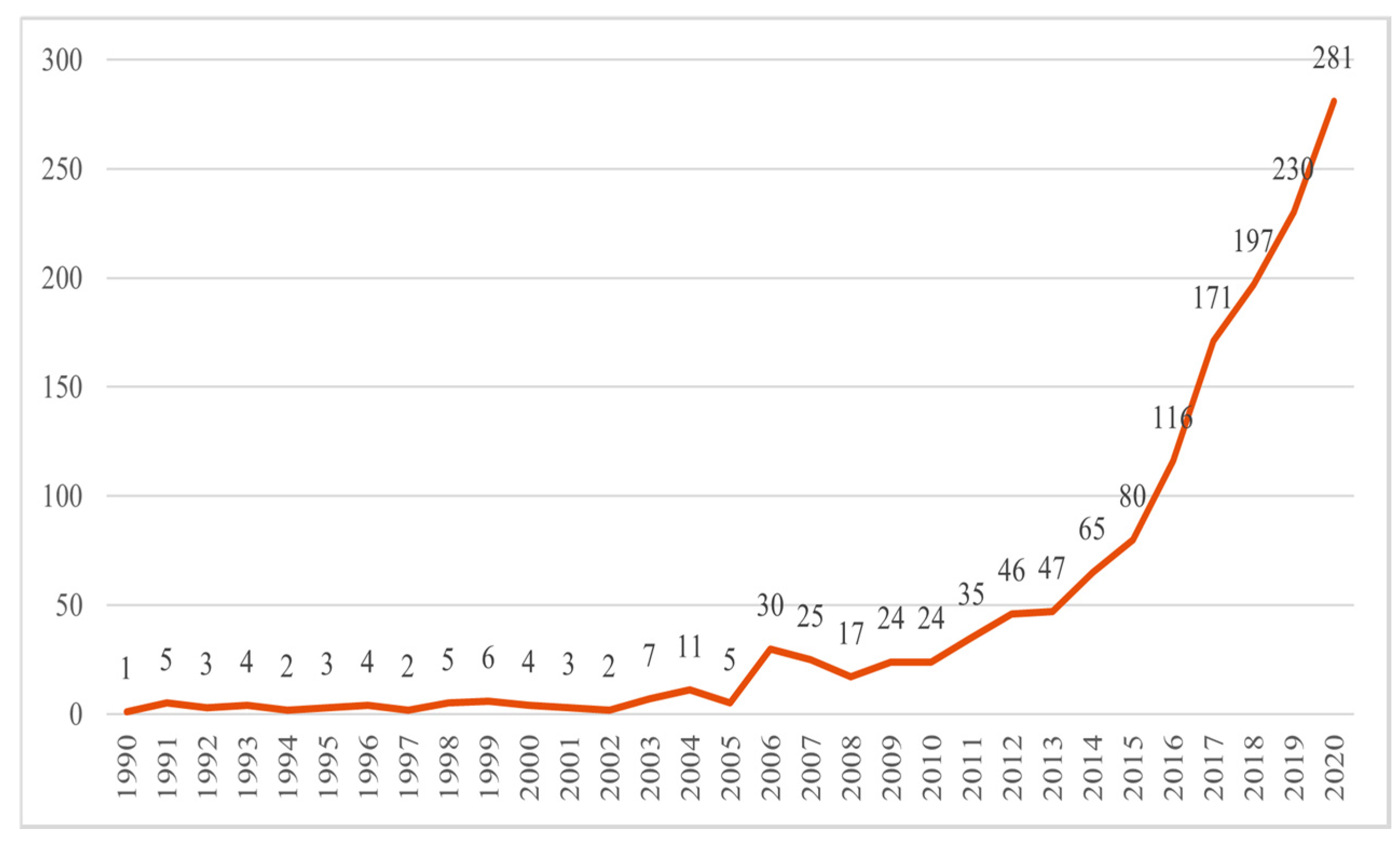
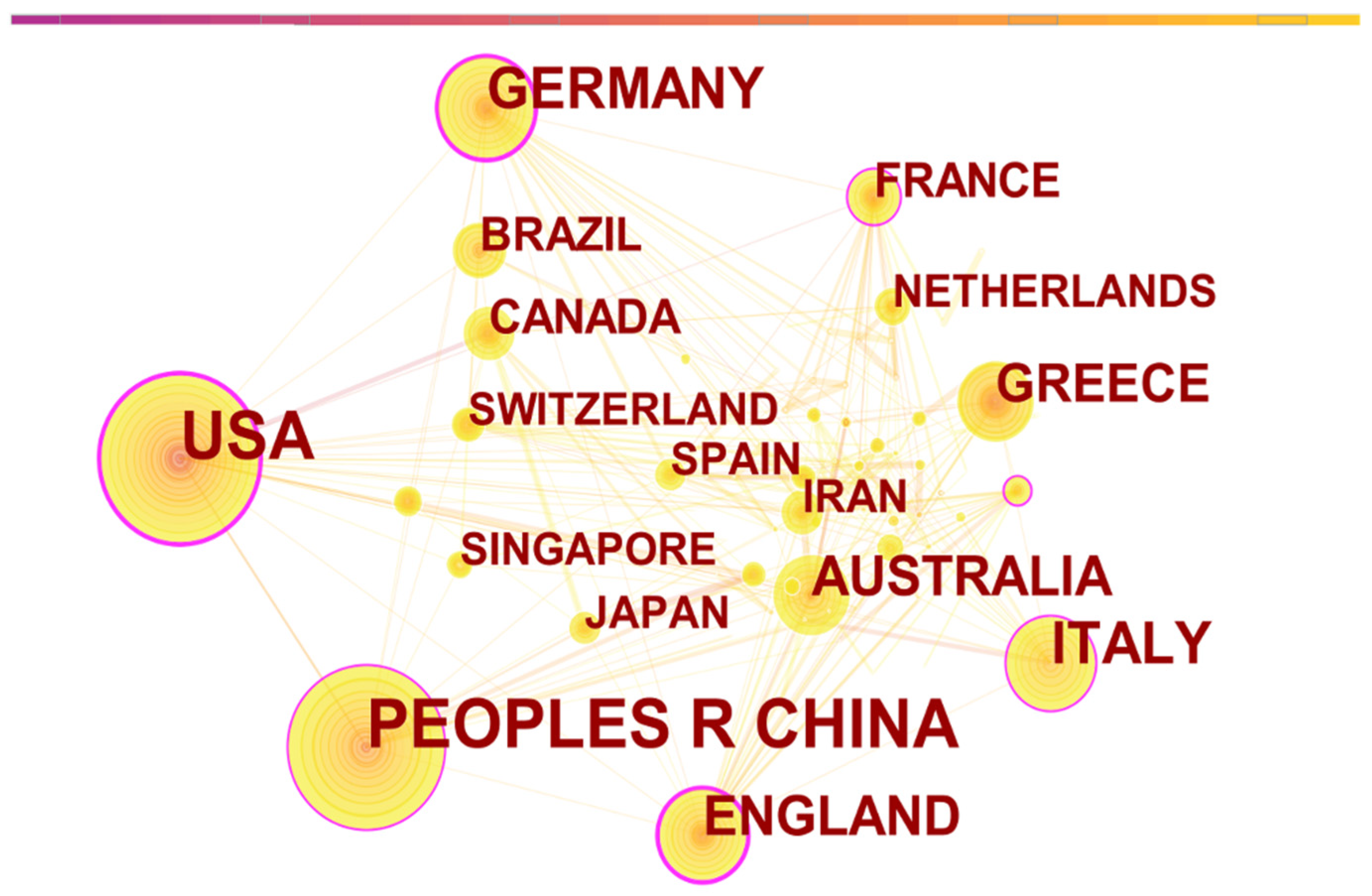
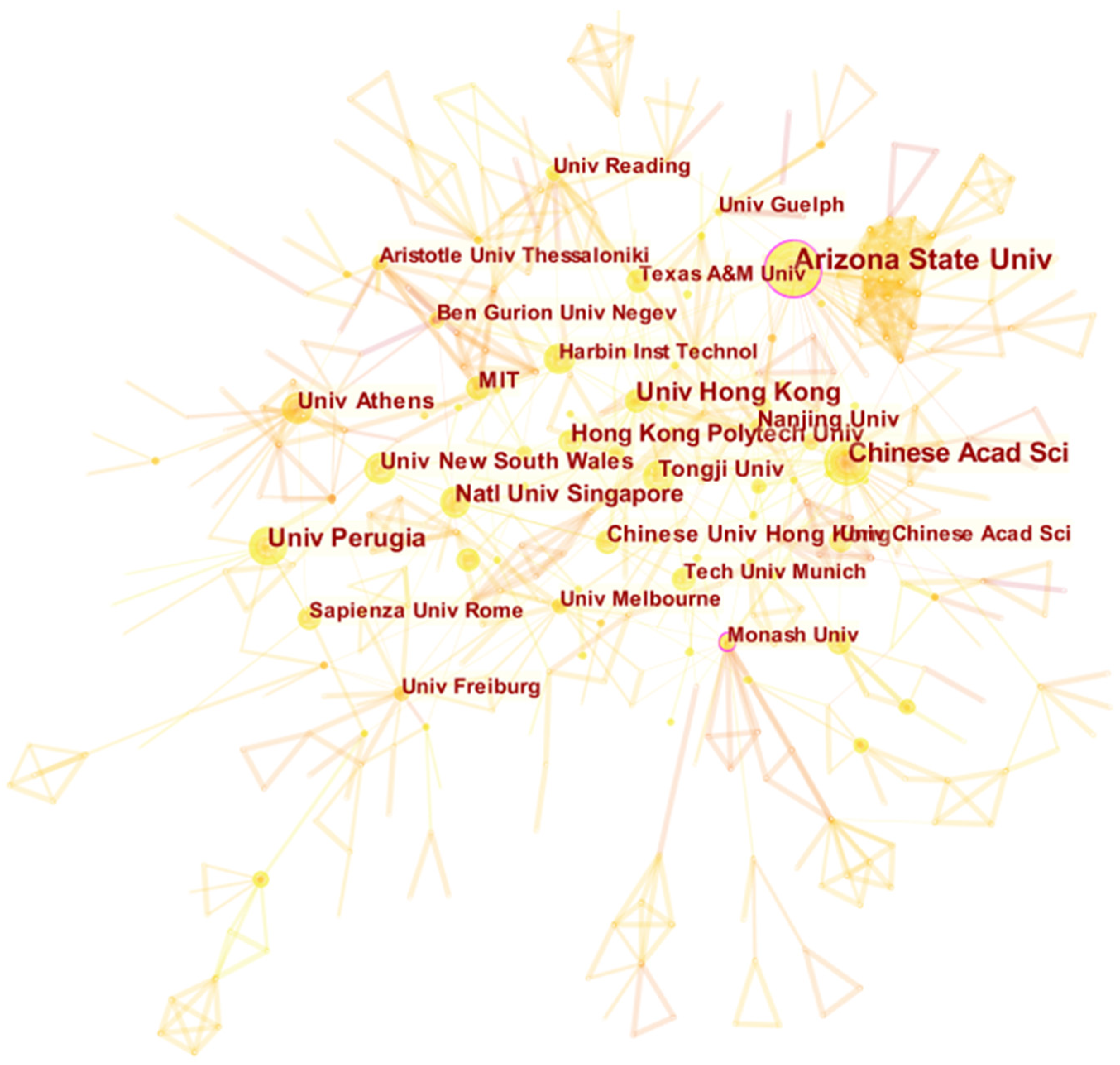
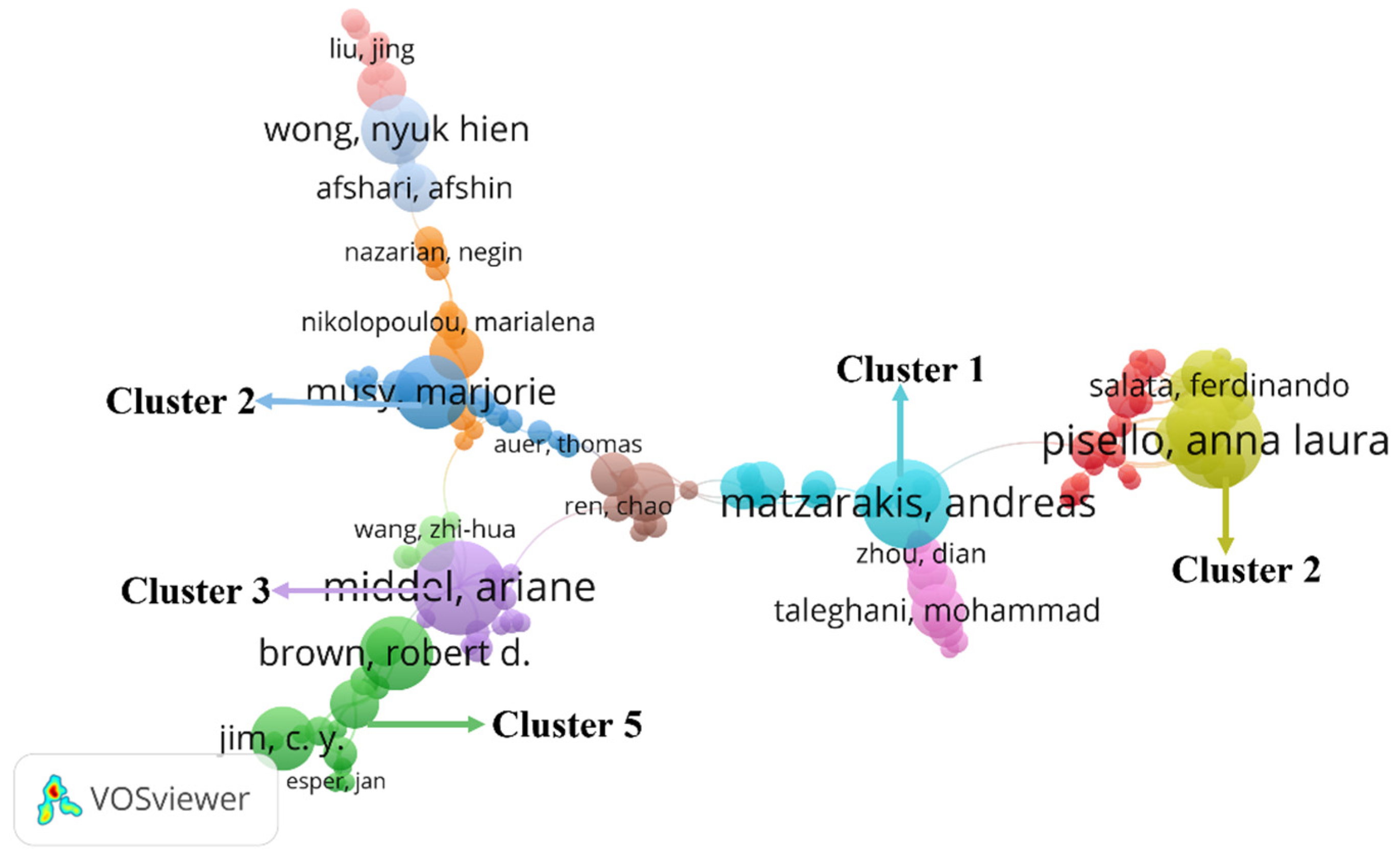
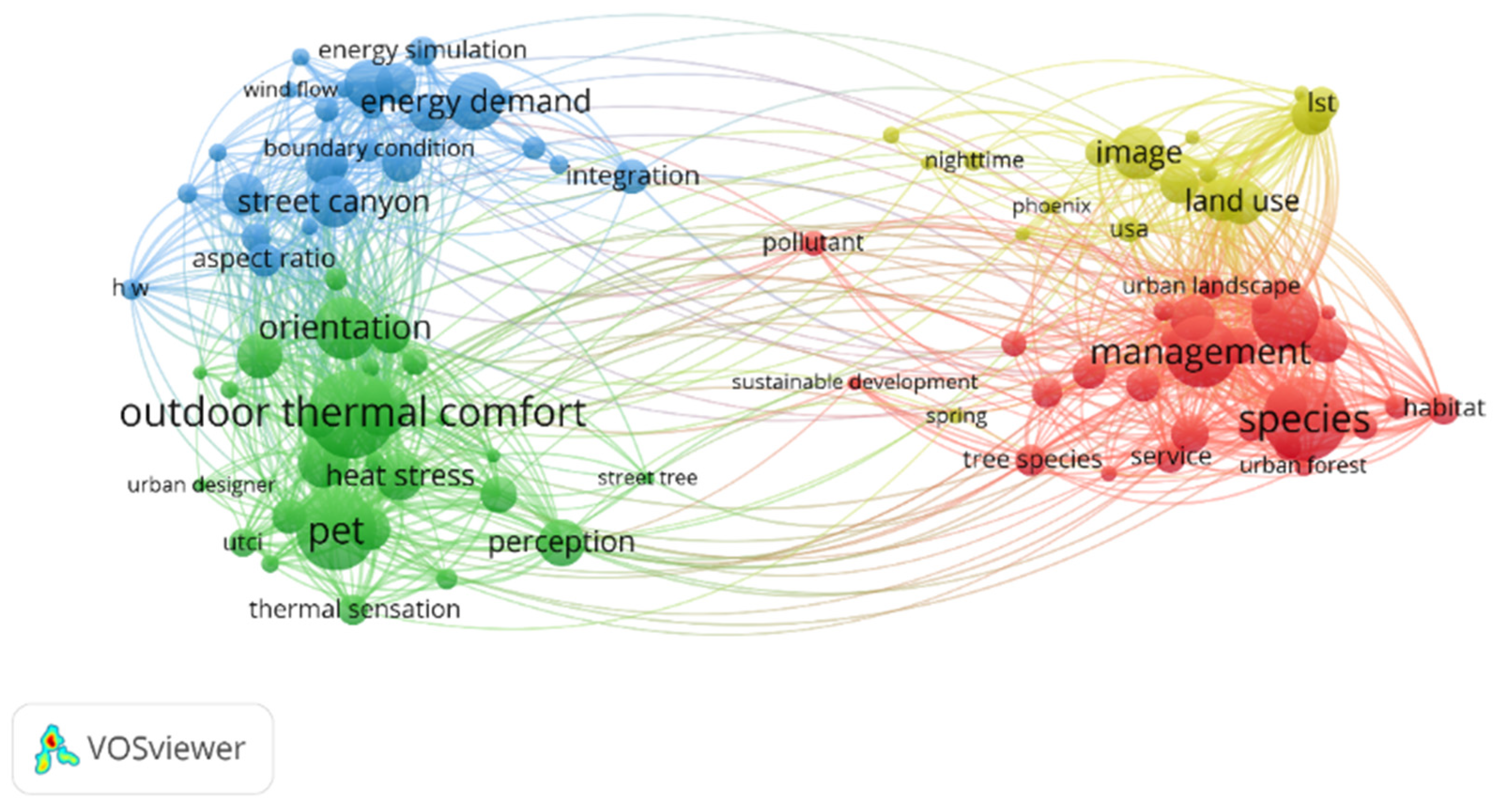
| Country | Publications | Centrality | Country | Publications | Centrality | Publications |
|---|---|---|---|---|---|---|
| PEOPLES R CHINA | 311 | 0.14 | AUSTRALIA | 102 | 0.04 | 311 |
| USA | 279 | 0.32 | GREECE | 85 | 0.02 | 279 |
| ITALY | 127 | 0.11 | FRANCE | 56 | 0.18 | 127 |
| GERMANY | 125 | 0.30 | CANADA | 53 | 0.08 | 125 |
| ENGLAND | 102 | 0.24 | BRAZIL | 48 | 0.05 | 102 |
| Institution | Publications | Centrality | Institution | Publications | Centrality |
|---|---|---|---|---|---|
| Arizona State University | 47 | 0.18 | Hong Kong Polytech University | 23 | 0 |
| Chinese Academy of Sciences | 34 | 0.08 | Tongji University | 21 | 0.04 |
| University Hong Kong | 25 | 0.1 | University New South Wales | 20 | 0.04 |
| University Perugia | 25 | 0.01 | University Athens | 19 | 0.06 |
| Natl University Singapore | 24 | 0.04 | Chinese University Hong Kong | 18 | 0.08 |
| Name | Number |
|---|---|
| Ariane Middle | 16 |
| Anna Laura Pisello | 15 |
| Jan Carmeliet | 12 |
| C. Y. Jim | 12 |
| Jonas Allegini | 10 |
| No. | Year | Author | Journal | Country/Insititute | Topic | Citations |
|---|---|---|---|---|---|---|
| 1 | 2010 | Bowler, D.E. et al. | LANDSCAPE AND URBAN PLANNING | Wales/Bangor University | Greenery | 1038 |
| 2 | 1999 | Matzarakis, A. et al. | INTERNATIONAL JOURNAL OF BIOMETEOROLOGY | Germany/University Freiburg | PET | 535 |
| 3 | 1998 | Bruse, M.; Fleer, H. | ENVIRONMENTAL MODELLING & SOFTWARE | Germany/Ruhr University Bochum | ENVI-met | 487 |
| 4 | 2006 | Ali-Toudert, F.; Mayer, H. | BUILDING AND ENVIRONMENT | Germany/University Freiburg | Outdoor thermal comfort | 478 |
| 5 | 2008 | Alexandria, E.; Jones, P. | BUILDING AND ENVIRONMENT | Wales/Cardiff University | Outdoor thermal comfort | 451 |
| 6 | 2012 | Ng, E. et al. | BUILDING AND ENVIRONMENT | Peoples R China/Chinese University Hong Kong | Urban design; Steeet canyon | 401 |
| 7 | 2006 | Fisher, J.I. et al. | REMOTE SENSING OF ENVIRONMENT | USA/Brown University | Landsat; Greenery | 350 |
| 8 | 2006 | Nikolopoulou, M.; Lykoudis, S. | BUILDING AND ENVIRONMENT | England/ University Bath; Greece/Natl Observ Athens | Outdoor thermal comfort | 334 |
| 9 | 2003 | Dimoudi, A.; Nikolopoulou, M. | ENERGY AND BUILDINGS | Greece/Ctr Renewable Energy Source | Greenery | 330 |
| 10 | 2000 | Carlson, T.N.; Arthur, S.T. | GLOBAL AND PLANETARY CHANGE | USA/Penn State University | Microclimatic variables | 325 |
| 11 | 2007 | Ali-Toudert, F.; Mayer, H. | SOLAR ENERGY | Germany/University Freiburg | Street canyon | 301 |
| 12 | 2007 | Chang, C.R. et al. | LANDSCAPE AND URBAN PLANNING | Taiwan/Chinese Culture University | Urban park | 290 |
| 13 | 2013 | Lovell, S.T.; Taylor, J.R. | LANDSCAPE ECOLOGY | USA/University Illinois | Management | 275 |
| 14 | 2014 | Middel, A. et al. | LANDSCAPE AND URBAN PLANNING | USA/Arizona State University; Germany/ University Kaiserslautern | Urban form and design | 268 |
| 15 | 2006 | Johansson, E. | BUILDING AND ENVIRONMENT | Sweden/Lund University | outdoor thermal comfort | 261 |
| 16 | 2003 | Steemers, K. | ENERGY AND BUILDINGS | England/University Cambridge | Energy demand | 259 |
| 17 | 2003 | Dousset, B.; Gourmelon, F. | ISPRS JOURNAL OF PHOTOGRAMMETRY AND REMOTE SENSING | USA/University Hawaii; France/UBO | Urban landscape; Summertime microclimate | 251 |
| 18 | 2007 | Jenerette, G.D. et al. | LANDSCAPE ECOLOGY | USA/Ohio State University | Surface temperature; Greenery | 247 |
| 19 | 2015 | Taleghani, M. et al. | BUILDING AND ENVIRONMENT | Netherlands/Delft University Technology | Outdoor thermal comfort | 242 |
| 20 | 2011 | Matzarakis, A. et al. | INTERNATIONAL JOURNAL OF BIOMETEOROLOGY | Israel/Ben Gurion University Negev | Greenery; Outdoor thermal comfort | 240 |
Publisher’s Note: MDPI stays neutral with regard to jurisdictional claims in published maps and institutional affiliations. |
© 2022 by the authors. Licensee MDPI, Basel, Switzerland. This article is an open access article distributed under the terms and conditions of the Creative Commons Attribution (CC BY) license (https://creativecommons.org/licenses/by/4.0/).
Share and Cite
Li, J.; Mao, Y.; Ouyang, J.; Zheng, S. A Review of Urban Microclimate Research Based on CiteSpace and VOSviewer Analysis. Int. J. Environ. Res. Public Health 2022, 19, 4741. https://doi.org/10.3390/ijerph19084741
Li J, Mao Y, Ouyang J, Zheng S. A Review of Urban Microclimate Research Based on CiteSpace and VOSviewer Analysis. International Journal of Environmental Research and Public Health. 2022; 19(8):4741. https://doi.org/10.3390/ijerph19084741
Chicago/Turabian StyleLi, Jiajing, Yang Mao, Jingyi Ouyang, and Shuanning Zheng. 2022. "A Review of Urban Microclimate Research Based on CiteSpace and VOSviewer Analysis" International Journal of Environmental Research and Public Health 19, no. 8: 4741. https://doi.org/10.3390/ijerph19084741
APA StyleLi, J., Mao, Y., Ouyang, J., & Zheng, S. (2022). A Review of Urban Microclimate Research Based on CiteSpace and VOSviewer Analysis. International Journal of Environmental Research and Public Health, 19(8), 4741. https://doi.org/10.3390/ijerph19084741





